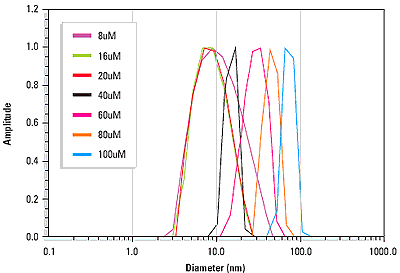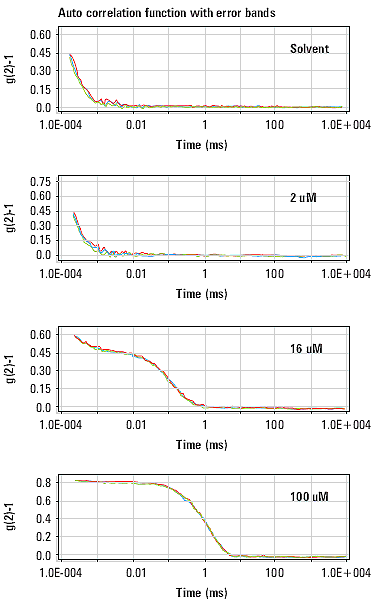New lead compounds for drug design are typically discovered using high throughput combinatorial techniques that utilize large screening databases of known compounds. These small molecule databases however, have been shown to contain promiscuous inhibitors that function as effective enzyme inhibitors, while exhibiting non-drug- like traits such as poor specificity and uncorrelated structure-function relationships.
The Concentration Dependent Inhibitory Nature of These Promiscuous Inhibitors
Recent studies indicate that the concentration dependent inhibitory nature of these promiscuous inhibitors is a direct consequence of non-specific aggregation, i.e. when the molecule is aggregated it functions as an effective inhibitor; when aggregation is absent, so is the inhibitory activity of the compound. While the mechanism for this aggregation controlled inhibition is still under examination, the suggested pathway is one wherein the enzyme absorbs either onto the surface or into the interior of the drug aggregate, which subsequently restricts active site access.
Dynamic Light Scattering for Measuring Particle Size
Photon correlation spectroscopy or dynamic light scattering (DLS) is an analytical technique capable of measuring the size of very small particles, at low sample concentrations. Because of the molecular weight dependence of the particle scattering intensity, the technique is extremely sensitive to the presence of aggregates. As such, DLS is an ideally suited screening tool for identifying promiscuous inhibitors from the cache of lead compound candidates selected from small molecular databases.
Case Study
This application note summarizes measurements performed on a candidate drug that exhibits inhibitory behavior at certain concentrations.
The concentration dependent aggregation of the compound was examined using dynamic light scattering.
Particle Sizing Equipment
Sizing measurements were collected with a Malvern Panalytical High Performance Particle Sizer (HPPS).
Sample Preparation
Samples were prepared in deionized water, and at least 3 measurements were collected for each concentration to check repeatability.
Results
Demonstration of Aggregation
Figure 1 shows the size distributions obtained for the compound at 8, 16, 20, 40, 60, 80, and 100 µM concentrations. As evident from the size distributions and the associated mean diameter results in Table 1, the compound is aggregated at concentrations ≥8 µm.

Figure 1. Dynamic light scattering size distributions for the candidate drug at 8, 16, 20, 40, 60, 80, and 100 μM concentrations in deionized water.
Table 1. Sizing results for the candidate drug.
|
|
|
|
2
|
-
|
|
4
|
-
|
|
6
|
-
|
|
8
|
100.8
|
|
16
|
88.9
|
|
20
|
83.8
|
|
40
|
154
|
|
60
|
281
|
|
80
|
436
|
|
100
|
712
|
Although the HPPS can measure particles and molecules as small as 0.6 nm, the particle refractive index and concentration must be such that scattering is observed in excess of the scattering from the dispersant. This is obviously not the case when this sample is present at a concentration below 8 μm.
Support for the Absence of Aggregation
Support for the absence of aggregation at compound concentrations < 8 M is given in Figure 2, which shows a comparison of the correlation curves for the 100 µM, 16 µM, and 2 µM samples and the solvent background. DLS measures the time-dependent fluctuations in the intensity of scattered light that occur due to Brownian motion. The frequency of these fluctuations is dependent upon particle size, and the correlogram shows the loss of correlation in the detected signal as a function of time, i.e. how rapidly the intensity fluctuations are occurring. As indicated in Figure 2, there is no significant difference between the solvent and the 2 µM sample, suggesting negligible compound aggregation at the lower concentrations.

Figure 2. DLS correlation curves for the 100, 16, and 2µM samples and the solvent background.
Malvern Panalytical High Performance Particle Sizer (HPPS)
The High Performance Particle Sizer (HPPS) from Malvern Panalytical was specifically designed to meet the low concentration and sample volume requirements typically associated with protein applications, along with the high concentration requirements for colloidal applications. Satisfying this unique mix of requirements was accomplished via the integration of a backscatter optical design. As a consequence of this design, the HPPS specifications for sample size, concentration, and volume exceed those for any other commercially available DLS instrument. The HPPS hardware is self optimizing, and the software includes a unique "one click" measure, analyze, and report feature designed to minimize the new user learning curve.

This information has been sourced, reviewed and adapted from materials provided by Malvern Panalytical.
For more information please visit Malvern Panalytical.